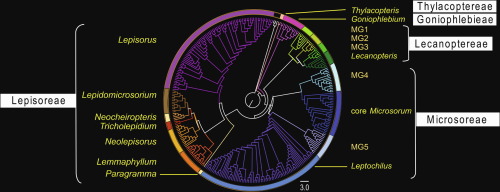当前位置:
X-MOL 学术
›
Mol. Phylogenet. Evol.
›
论文详情
Our official English website, www.x-mol.net, welcomes your feedback! (Note: you will need to create a separate account there.)
Exploring phylogeny of the microsoroid ferns (Polypodiaceae) based on six plastid DNA markers.
Molecular Phylogenetics and Evolution ( IF 4.1 ) Pub Date : 2019-11-05 , DOI: 10.1016/j.ympev.2019.106665 Chi-Chuan Chen 1 , Jaakko Hyvönen 2 , Harald Schneider 3
Molecular Phylogenetics and Evolution ( IF 4.1 ) Pub Date : 2019-11-05 , DOI: 10.1016/j.ympev.2019.106665 Chi-Chuan Chen 1 , Jaakko Hyvönen 2 , Harald Schneider 3
Affiliation

|
The microsoroid ferns are one of the largest subfamilies of the Polypodiaceae with over 180 species mainly found in the humid forests of tropical Australasia. The phylogenetic relationships are still unclear, especially the delimitation of the genus Microsorum which has been recognized to be non-monophyletic. We analysed the microsoroid ferns using six chloroplast DNA regions (rbcL, rps4+rps4-trnS, trnL+trnL-trnF, atpA, atpB and matK) in order to present a robust hypothesis of their phylogeny. Our results suggest that they comprise up to 17 genera; of them, 12 agree with a previously accepted generic classification. Five tribes are proposed based on the phylogenetic relationships. Most of the species traditionally included in the genus Microsorum are found in six genera belonging to two tribes. In addition to the commonly used DNA markers, the additional atpA and matK are helpful to provide information about the phylogenetic relationships of the microsoroid ferns.
中文翻译:

基于六个质体DNA标记探索微体蕨类植物(Polypodiaceae)的系统发育。
微型蕨类植物是Poly科最大的亚科之一,有180多种,主要见于热带大洋洲的湿润森林中。系统发育的关系仍不清楚,特别是Microsorum属的界限已被公认是非单系的。我们使用六个叶绿体DNA区域(rbcL,rps4 + rps4-trnS,trnL + trnL-trnF,atpA,atpB和matK)分析了微体蕨类植物,以提出其系统发育的可靠假设。我们的结果表明,它们包括多达17个属。其中12个同意先前接受的通用分类。根据系统发育关系,提出了五个部落。传统上包括在小种属中的大多数物种是在属于两个部落的六个属中发现的。除了常用的DNA标记外,
更新日期:2019-11-06
中文翻译:

基于六个质体DNA标记探索微体蕨类植物(Polypodiaceae)的系统发育。
微型蕨类植物是Poly科最大的亚科之一,有180多种,主要见于热带大洋洲的湿润森林中。系统发育的关系仍不清楚,特别是Microsorum属的界限已被公认是非单系的。我们使用六个叶绿体DNA区域(rbcL,rps4 + rps4-trnS,trnL + trnL-trnF,atpA,atpB和matK)分析了微体蕨类植物,以提出其系统发育的可靠假设。我们的结果表明,它们包括多达17个属。其中12个同意先前接受的通用分类。根据系统发育关系,提出了五个部落。传统上包括在小种属中的大多数物种是在属于两个部落的六个属中发现的。除了常用的DNA标记外,

























 京公网安备 11010802027423号
京公网安备 11010802027423号